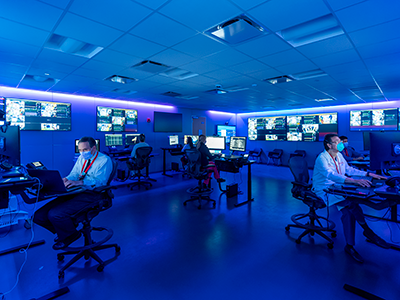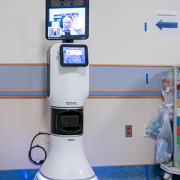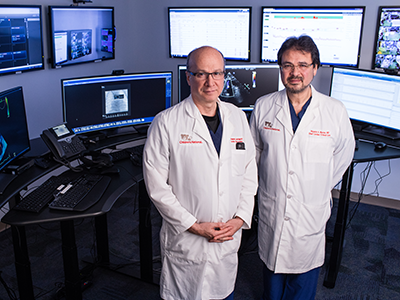New telehealth command center redefines hospital care

The new CICU command center redefines hospital care for children with the riskiest heart conditions.
Children’s National Hospital has opened a new telehealth command center that uses cutting-edge technology to keep continuous watch over the most fragile children with critical heart disease. The new command center, located in the Cardiac Intensive Care Unit (CICU), builds off a care model deployed outside the CICU in 2019, but now offers improved collaborative communication to better help predict and prevent major events, like cardiac arrest.
“The new center acts like an air traffic control tower. It allows our telehealth team to remotely monitor each patient room and alert the bedside team to any abnormal trends,” says Ricardo Munoz, M.D., executive director of the Telemedicine Program and chief of the Division of Critical Care Medicine at Children’s National. “Better communication with the bedside team and easier access to all members of the medical and surgical teams means we can provide the best possible care to these fragile infants.”
In the early stages of recovery after heart surgery, vulnerable patients can regress quickly with few outward physical symptoms. The telehealth virtual surveillance system flags early warning signs that a critically ill infant may suffer a serious adverse event.
The system combines traditional remote monitoring, video surveillance and an artificial intelligence algorithm. New features include:
- Neuromonitoring: Doctors are developing an adaptable neuromonitoring system that can help signal an impending brain injury before it happens.
- Echocardiography: A cardiologist, embedded in the new command center, is available to expedite and improve communication within the multidisciplinary team.
- Real-time audio and video: A telemedicine cart is placed in the room of high-risk patients to allow for rapid communication with a bedside nurse.
- E-CICU team: A team of CICU nurses and physicians implement a second layer of safety over patient care by doing a systematic review of video feeds from patient rooms, patient monitors, artificial intelligence tools trained to detect dangerous trends, labs and imaging studies.
Since the center’s launch, the system’s virtual surveillance has tracked 8,697 virtual surveillance activities, resulting in:
- 2,350 non-critical communications
- 199 critical communications that prevented major adverse events
“Parents of our highest-risk patients are comforted knowing our team of doctors and nurses are watching their child at every moment,” says Dr. Munoz. “We are one of the few pediatric hospitals in the world integrating telemedicine into our CICU. Our goal is to expand our monitoring capabilities both nationally and internationally to improve pediatric heart care.”
Children’s National is a recipient of the Telehealth Accreditation from URAC and is the first pediatric hospital to receive this recognition for its ability to leverage technologies to advance high-quality care that promotes clinical best practices, consumer protections and care continuity between patients and providers.
The Board of Visitors Telehealth Command Center was funded by an Auxiliary Board of Children’s National.






